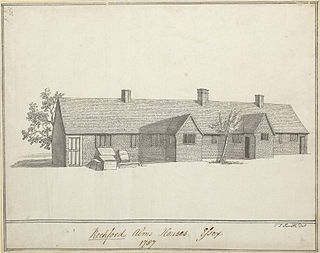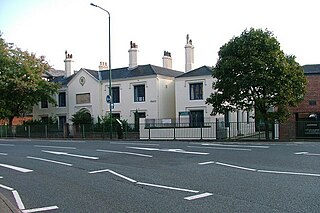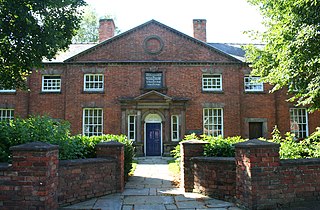
An almshouse is charitable housing provided to people in a particular community, especially during the Middle Ages. They were often targeted at the poor of a locality, at those from certain forms of previous employment, or their widows, and at elderly people who could no longer pay rent, and are generally maintained by a charity or the trustees of a bequest. Almshouses were originally formed as extensions of the church system and were later adapted by local officials and authorities.

Froxfield is a village and civil parish in the English county of Wiltshire. The parish is on the Wiltshire-West Berkshire border, and the village lies on the A4 national route about 2.5 miles (4 km) west of Hungerford and 7 miles (11 km) east of Marlborough.

Heytesbury is a village and a civil parish in Wiltshire, England. The village lies on the north bank of the Wylye, about 3+1⁄2 miles (5.6 km) southeast of the town of Warminster.

Ampton is a village and civil parish in the West Suffolk District of Suffolk, England, about five miles north of Bury St Edmunds.

The Bar Convent Living Heritage Centre, at Micklegate Bar, York, England, established in 1686, is the oldest surviving Catholic convent in the British Isles. The laws of England at this time prohibited the foundation of Catholic convents and as a result of this, the convent was both established and operated in secret.

Gray's Almshouses is a terrace of almshouses in Taunton, Somerset, England, founded in 1635 by the wealthy cloth-merchant Robert Gray, whose monument survives in the Church of St Mary Magdalene. The building is one of the oldest surviving in Taunton and is one of the earliest brick buildings in the county. The Almshouses were designed to provide accommodation for six men and ten women and for a reader who was to act as chaplain and schoolmaster. It is a Grade I listed building as designated by English Heritage. Following renovation in the late twentieth century it now comprises sheltered accommodation of nine flats for the elderly.

Sexey's Hospital in Bruton, Somerset, England was built around 1630 as almshouses. The West Wing and chapel have been designated as a Grade I listed building. The East Wing and gateway are grade II listed.

Plumptre Hospital was a charity in Nottingham, England, providing almshouse accommodation for 599 years from 1392 to 1991.

Crewe Almshouses or Crewe's Almshouses is a terrace of seven former almshouses at the end of Beam Street in Nantwich, Cheshire, England. The present building was erected in 1767 by John Crewe, later first Baron Crewe, and is listed at grade II. It has a central projecting section topped by a pediment, with a stone doorway flanked with Tuscan columns. The present almshouses stand on the site of a 16th-century building, originally the mansion of the Mainwaring family and later the town's House of Correction and workhouse.

Wright's Almshouses is a terrace of six former almshouses now located on Beam Street in Nantwich, Cheshire, England. The building was originally erected at the junction of Hospital Street and London Road in 1638 by Edmund Wright, Lord Mayor of London in 1640–41, and is listed at grade II*. The low red-brick terrace has stone dressings and a central stone panel with arms. The adjacent stone archway of 1667, which Nikolaus Pevsner describes as the "best" feature of the almshouses, is also listed separately at grade II*, together with its associated wall.

The Tollemache Almshouses, also known as the Wilbraham Almshouses or Wilbraham's Almshouses, are six former almshouses in Nantwich, Cheshire, England. They are in two blocks of three cottages each, located on the north side of Welsh Row at numbers 118–128. The present buildings, which are listed at grade II, were erected in 1870 by John Tollemache to replace adjacent almshouses founded by Sir Roger Wilbraham in 1613. The almshouses were modernised in 1980 and remain in residential use. The Hospital of St Lawrence, a medieval house for lepers, was possibly on or near the site of the present almshouses.

The Hospital of St John Baptist without the Barrs is a building with an adjacent chapel in the city of Lichfield, Staffordshire, England. It is a Grade I listed building.

Wandesford House is an eighteenth-century almshouse in the centre of York, England, one of twelve still-functioning almshouses in the city, and the oldest still in its original building. Built in 1739 and opened in 1743, the house is an important example of the classical style in the city. Like many historic almshouses, it was referred to as a hospital before that term became chiefly associated with medical establishments.

Richard Watts Charities incorporate Richard Watts Charity set up in the will of Richard Watts in 1579, as well as several other charities in Rochester, Medway. The will originally provided for an almshouse in Rochester High Street: The Poor Travellers House; over time, the money later provided for almshouses in Maidstone Road, along with other accommodation in Rochester, totalling 66 self-contained flats. Other charities absorbed by the Richard Watts Charity include St Catherine's Hospital founded under the Charity of Symond Potyn in 1315.

Trinity Hospital, is a group of almshouses between Greenwich Power Station and the Old Royal Naval College on the south bank of the River Thames at Greenwich, London, England.

The Percy and Wagner Almshouses are a group of 12 almshouses in the inner-city Hanover area of the English coastal city of Brighton and Hove. The first six date from 1795 and are among the few pre-19th-century buildings left in the city. Six more were added in a matching style in 1859. They are the only surviving almshouses in Brighton and have been listed at Grade II for their architectural and historical importance.

Lady Anne House is a former almshouse, now a hotel, in York, in England.

Dorothy Calthorpe (1648-1693) was a philanthropist and an author of poetry known for an autograph manuscript volume containing poems, a prose romance, and two devotional prose narratives.

Lady Hewley's Almshouses are a historic building in the city centre of York, in England.




















